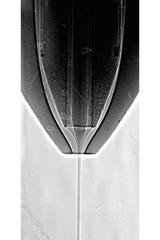URL: https://www.desy.de/news/news_search/index_eng.html
Breadcrumb Navigation
DESY News: Novel nozzle saves crystals
News
News from the DESY research centre
Novel nozzle saves crystals
Thanks to an innovative nozzle, scientists can now analyse more types of proteins while using fewer of the hard-to-get protein crystals. The nozzle can reduce protein consumption eightfold in serial X-ray crystallography experiments, as the team of inventors, headed by DESY scientist Saša Bajt from the Center for Free-Electron Laser Science (CFEL), writes in the journal Scientific Reports. The researchers used their novel nozzle to reveal hitherto unseen details of the structure of an RNA polymerase enzyme.

Radiograph of the working nozzle, showing the inner protein stream surrounded by the ethanol jet. Credit: Dominik Oberthür, DESY
Many proteins do not like being squeezed into crystals as it contradicts their natural function. “Growing protein crystals is complex, the amount of protein that can be produced is often limited to few millionth of a gram and often only very tiny crystals can be obtained,” says Dominik Oberthür from DESY, main author of the report. With the extremely bright flashes of X-ray free-electron lasers even those micro crystals can be analysed, but usually thousands of diffraction patterns are needed to solve the protein structure. Since the delicate micro crystals are completely vaporised by the intense X-ray flash – after they delivered their diffraction pattern – a stream of fresh micro crystals is sent through the laser beam. This concept is known as serial X-ray crystallography and has enabled the analysis of many previously inaccessible proteins.
Still, even those micro crystals are hard to obtain, and only a fraction of them is actually hit by an X-ray flash, depending on the geometry of the crystal stream and the technical parameters of the X-ray laser. “The less crystals, the less protein material you need, the more feasible is the analysis,” emphasises Oberthür. Bajt's team conceived a new concept for a so-called double flow-focusing nozzle (DFFN) that greatly reduces protein crystal consumption. Usually, the protein crystals are injected with some carrier liquid (“buffer”) into the X-ray beam, using a special nozzle. To form a thin jet, the carrier liquid is accelerated by a fast stream of gas surrounding the liquid. But to form a stable jet, a minimum flow rate is needed, usually wasting most of the crystals in the jet.

Concept of the novel nozzle: a fast jet of gas (white) accelerates a stream of ethanol (blue) in which the protein crystals carrying buffer (green) is injected. Credit: Anton Barty, DESY, and Juraj Knoška, Universität Hamburg
“Not only do we reduce crystal consumption, but our double flow-focusing nozzle also makes the use of the X-ray source more efficient by increasing the rate at which we collect high-quality diffraction patterns”, says Bajt. “Moreover, using the sheath liquid allows us to investigate proteins in buffers that couldn't be injected before. Our concept widens the spectrum of biomolecules that can be analysed.” Her team tested the new nozzle at the X-ray laser LCLS of the SLAC National Accelerator Laboratory in the US. The scientists teamed up with different groups to solve the structures of various proteins.

The first room-temperature structure of the enzyme RNA polymerase II (here shown as cartoon plot) could be solved by serial femtosecond crystallography using a double flow-focused nozzle. Credit: Dave Bushnell, Stanford University, and Dominik Oberthür, DESY
The double flow-focusing nozzle also does away with another practical problem of this form of jet injection: Usually, at the edge of conventional nozzles, buffer material, protein and water ice crystals aggregate over time to form dripstone-like features. The same frequently happens at the bottom of the catch tank below the nozzle. If these protein-ice stalactites and stalagmites grow into the X-ray beam, they do not only render the diffraction pattern useless, their reflections can be so strong that they destroy the detector. So, every now and then, experiments need to be suspended to remove the protein-ice dripstones. “The sheath liquid in our nozzle prevents formation of such unwanted structures. The double flow-focusing nozzle enabled stable experimental conditions for many hours,” explains Oberthür.
“In all experiments the nozzle worked extremely well,” summarises Bajt. “We could reduce the number of interruptions from ten to zero in a shift, and we expect that experimental stations at other X-ray lasers and at synchrotron light sources like DESY's PETRA III can also benefit from the advantages of our device.”
The Arizona State University, the Cornell University, the University of Minnesota, the Technical University of Berlin, the Charité Universitätsmedizin Berlin, the Hauptmann-Woodward Medical Research Institute, the University of Nova Gorica, the Institute of Metals and Technology in Ljubljana, the Helmholtz-Zentrum Geesthacht, the University of Hamburg, and the Hamburg Centre for Ultrafast Imaging CUI were also involved in this research. CFEL is a cooperation of DESY, the University of Hamburg and the German Max Planck Society.
Reference:
Double-flow focused liquid injector for efficient serial femtosecond crystallography; Dominik Oberthür et al.; „Scientific Reports“, 2017; DOI: 10.1038/srep44628



